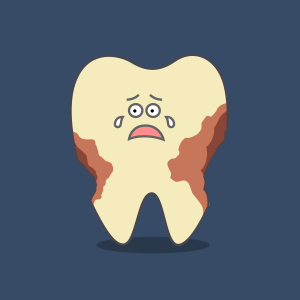Brushing your teeth is an integral part of your daily oral hygiene routine, and should be paired with regularly scheduled dental exams and cleanings. By brushing your teeth thoroughly for at least two minutes, twice per day and flossing at least once per day you can remove plaque, prevent gum disease, and prevent tooth decay.
Let’s Talk About Plaque

What is Plaque?
Dental plaque is a clear, sticky film that is formed by eating sugary and starchy foods and not cleaning our teeth effectively. When starches and sugars are left on our teeth, they become food for bacteria, which end up forming plaque. If plaque is not removed, it can harden into tartar, which will need to be removed by your dental team using specialized cleaning tools. Tartar provides a shield for bacteria, allowing them to flourish.
Why is Plaque Bad?
Plaque is acidic, and will slowly eat away at your tooth enamel, creating tiny openings. These openings are the first stage of tooth decay. Once the tooth enamel is eaten away the acid and bacteria can reach the next layer of your tooth, the dentin. This layer is much softer than enamel and is more easily damaged by plaque and bacteria. The dentin is connected to your nerves by tiny tubes, and when the plaque and bacteria enter those tubes, it can cause you pain.
If the plaque and bacteria eat their way through your dentin, they reach the final, inner layer of your tooth: the pulp. The pulp contains blood vessels and nerves. When it is attacked by bacteria and plaque the tissue in the pulp portion of your tooth becomes inflamed and irritated. Since there is no room for the swollen tissue to expand within your tooth the nerve becomes pressed and pinched, causing pain.
When our teeth are damaged by acid and plaque, we get cavities, which can lead to a variety of other, much more severe problems. These can include swelling or pus around your tooth, damaged or broken teeth, and problems chewing. If the infection is not treated, you may develop an abscess, which can lead to a severe or even life-threatening infection.
How Long Should I Brush For?
You should be brushing your teeth for at least two minutes, spending about thirty seconds on each quadrant (upper right, upper left, bottom right, and bottom left).
However, brushing is most effective when it is combined with daily flossing, which allows you to remove plaque and bacteria from below your gum line and between your teeth where your toothbrush can’t reach. According to the Canadian Dental Association individuals who don’t floss are typically missing up to a third of their tooth surface.
Brushing is also beneficial because it strengthens your tooth enamel, fortifying it against acid and plaque and making it less likely that you will develop cavities.
Can I Brush My Teeth Too Much?
Brushing for longer than two minutes is not particularly beneficial, so there isn’t any added benefit if you brush for longer unless you are concerned that you missed a spot on your first pass.
However, you should be aware of how hard you are brushing. Brushing too hard can actually wear away your tooth enamel, weakening your tooth’s protective outer layer and leaving you vulnerable to cavities. Brushing too hard can also damage your gums, causing them to recede and making you more susceptible to tooth sensitivity and gum disease.
To help ensure you aren’t inadvertently causing damage you should choose a soft-bristled toothbrush and try brushing with your non-dominant hand.
Though you should be brushing at least twice per day, ideally you would brush your teeth after every meal, though that isn’t always feasible. For more information about proper at-home oral hygiene, or to request an appointment, please contact us or visit our website.








